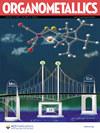Flash Communication: An ortho-Trifluoromethylphenyl Substituted Phosphine Ligand for Applications in Gold(I) Catalysis
IF 2.9
3区 化学
Q2 CHEMISTRY, INORGANIC & NUCLEAR
引用次数: 0
Abstract
Synthesis of the new bulky phosphine ligand di(1-adamantyl)-2-trifluoromethyphenylphosphine is reported, which coordinates with the trifluoromethyl group projected toward the metal center and exhibits a %Vbur of 47.3%. Well-defined gold(I) derivatives demonstrate higher catalytic activity for the cycloisomerization of 4-fluoro-N-(prop-2-yn-1-yl)benzamide than di(1-adamantyl)-2-biphenylphosphine (AdJohnPhos) and di(1-adamantyl)phenylphosphine analogues.
闪光通信:邻三氟甲基苯基取代膦配体在金催化中的应用(I)
合成了体积较大的二(1-金刚烷基)-2-三氟甲基苯基膦配体,该配体与金属中心的三氟甲基配位,Vbur为47.3%。定义明确的金(I)衍生物比二(1-金刚烷基)-2-联苯膦(AdJohnPhos)和二(1-金刚烷基)苯基膦类似物对4-氟- n- (prop-2-yn-1-yl)苯酰胺的环异构化具有更高的催化活性。
本文章由计算机程序翻译,如有差异,请以英文原文为准。
求助全文
约1分钟内获得全文
求助全文
来源期刊

Organometallics
化学-无机化学与核化学
CiteScore
5.60
自引率
7.10%
发文量
382
审稿时长
1.7 months
期刊介绍:
Organometallics is the flagship journal of organometallic chemistry and records progress in one of the most active fields of science, bridging organic and inorganic chemistry. The journal publishes Articles, Communications, Reviews, and Tutorials (instructional overviews) that depict research on the synthesis, structure, bonding, chemical reactivity, and reaction mechanisms for a variety of applications, including catalyst design and catalytic processes; main-group, transition-metal, and lanthanide and actinide metal chemistry; synthetic aspects of polymer science and materials science; and bioorganometallic chemistry.
 求助内容:
求助内容: 应助结果提醒方式:
应助结果提醒方式:


